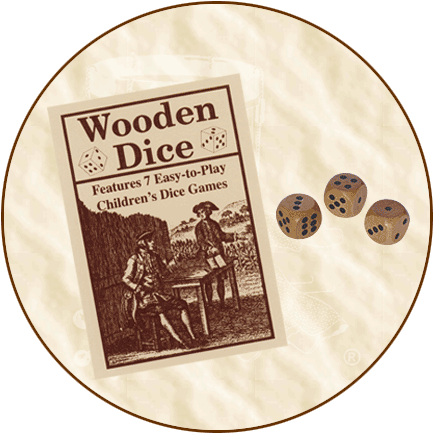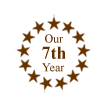.
Continued from product description on
Traditional Games' Page Three...
Historical
Background: Playing with dice dates back to ancient Greece
and Rome. Dice are commonly associated with gambling but there
are many other games that can be played for fun. Names for the
forerunners of dice games were Astragali and Knucklebones. A
game of this type is depicted in a 3rd-century B.C. Roman sculpture
featuring two girls close to the ground, one of them in the position
to roll. Astragali are the knucklebones of a goat. Other knucklebones
are the dried ankle bones of sheep and have four different sides,
flat, concave, convex, and one sinuous or curvy side. The name
"k'ab" is the Arabic word for "knucklebone"
and "die." The game of jacks is also known as "knucklebones"
because sheep bones were used to play a game which was the forerunner
of jacks.
When playing dice-like games, values were given to each side
of the knucklebones. The bones were tossed into the air and a
player tried to have them land on the back of the hand or on
the ground. Points were determined and scores kept. Eventually,
six-sided cubed dice replaced the bones. A cube-shaped dotted
die dated 600 B.C. from the Greek colony of Naucratis, Egypt,
was discovered by Flinders Petrie.
Colonial American children played with dice and wealthy families
would have had ivory dice, while the "common folk"
would have used wooden dice. Dice have been made of bone, antler,
ivory, horn, wood and, later during the American Revolutionary
War, soldiers made dice out of lead bullets and played dice games
to pass the time.
Dominoes are closely associated with dice. Domino spots look
like two dice placed side by side. Dominoes, along with dice,
may have been used in fortune telling as long ago as 1120 A.D.
As with playing cards, dice had gambling issues that caused
prohibitions and ordinances to be passed. In 1364 in St. Gallen
Switzerland, an ordinance forbade dice games, allowed board games,
but did not mention playing cards. In 1382 in Lille, France,
an ordinance forbade various games, including dice and "quartes"
(an early word for cards). In the same year in Barcelona, Spain,
an ordinance prohibited dice and cards in just one home of a
certain town official. Fifteen years later in Paris, France,
a decree was issued forbidding working people to play dice and
other gambling-type games on working days.
Many dice games made use of a cup to shake the dice in, rather
than in a hand. It seems that this method kept some players from
"palming" loaded dice. Loaded dice are dice that have
been tampered with to cause a predictable outcome. The "shaker
cup" supposedly made dice playing a fair game. The dice
could, however, still be "loaded" by a skilled cheat.













